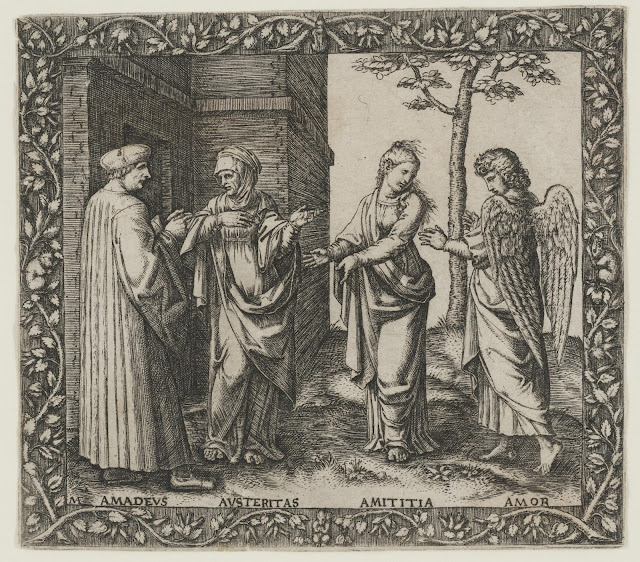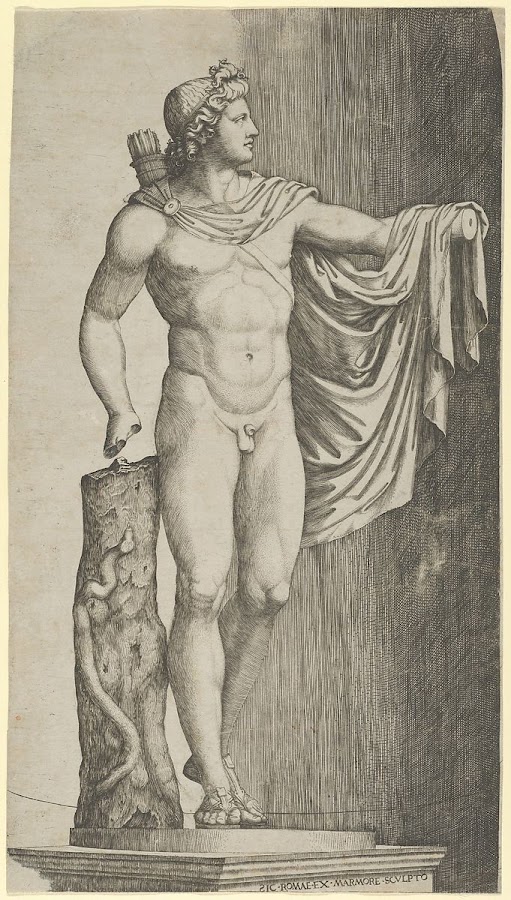An important Renaissance engraver, Raimondi's first prints stem from ca.1500-1505 and show both the influence of Bolognese engravers such as Francia and Lorenzo Costa, as well as Dürer. From ca.1506 - ca. 1508, he was in Venice, making a total of 74 prints after woodcuts by Dürer. During this period, he also made engravings after works by Giorgione and Michelangelo. By ca.1510, Raimondi was in Rome and had befriended Raphael, who included Raimondi's portrait in his Vatican fresco depicting the Expulsion of Heliodorus. From ca.1510-1520, Raimondi, influenced by Raphael, primarily engraved designs by the latter and his followers. His style matured, and featured more fluidity in depicting subjects in motion. Raimondi also collaborated with Baviera on prints that, evidence suggest, were reproduced many times. According to Vasari, the 1527 Sack of Rome left Raimondi destitute. His engravings cannot be accounted for beyond that date.
For more detailed biographical notes see part 1. For earlier works see parts 1 & 2 also.
This is part 3 of 5 parts on the works of Marcantonio Raimondi:
 |
| c1500-1534 The Virgin and the Christ Child seated on clouds, after Raphael engraving 17.6 x 13.4 cm Metropolitan Museum of Art, New York |
 |
| c1500-1534 Two naked figures, after Raphael engraving 7.2 x 4.6 cm Metropolitan Museum of Art, New York |
 |
| c1500-1534 Two Naked Men, possibly after Michelangelo Buonarroti engraving 16.3 x 12.2 cm Metropolitan Museum of Art, New York |
 |
| c1500-1534 Venus attended by Cupids, after Raphael engraving 8.1 x 5 cm Metropolitan Museum of Art, New York |
 |
| 1504-1514 Philoteo Achillini engraving 18.4 x 13.3 cm Art Institute of Chicago, IL |
 |
| 1504-1514 Sign of the Ram engraving 17.5 x 13 cm Art Institute of Chicago, IL |
 |
| c1504 The Adoration of the Shepherds engraving 36.2 x 26.8 cm Metropolitan Museum of Art, New York |
 |
| 1505 Thisbe finding Pyramus laying on the ground with a knife in his chest engraving 23.4 x 20.5 cm Metropolitan Museum of Art, New York |
 |
| c1505 Venus and Vulcan after Francesco Francia engraving made up with pen an and ink 25.5 x 20.4 cm Metropolitan Museum of Art, New York |
 |
| 1506 Apollo, Hyacinthus and Cupid, after Francesco Francia? engraving 22.5 x 29.9 cm Metropolitan Museum of Art, New York |
 |
| 1506 Venus, after Giacomo Francia? engraving 21.4 x 15.2 cm Metropolitan Museum of Art, New York |
 |
| c1506 David and Goliath engraving 16.5 x 11.1 cm Metropolitan Museum of Art, New York |
 |
| c1506 Standing male nude pen and brown ink on paper 17.8 x 9.2 cm Metropolitan Museum of Art, New York |
c1506 The Offer of Love
Albrecht Dürer resorted to legal action to protect his artworks from copyists, based in part on Marcantonio Raimondi’s practice of reissuing woodcuts from Dürer’s Life of the Virgin book as engravings. This secular engraving (representing two lovers acting out of ulterior, financial motives) is one case in which the print media matches the original. Stylistically, there is no comparison between the intricacy of Dürer’s lines and Marcantonio’s dryer flecks and outlines. But contemporary buyers did not always know the difference. Although Dürer won the right to exclusive use of his “AD” monogram, the Venetian senate ruled that his images could still be copied.
 |
| c1506 The Offer of Love, after Albrecht Dürer engraving 15.5 x 14.1 cm Art Institute of Chicago, IL |
 |
| 1508 Mars seated at the left, his left hand on Venus's shoulder, cupid beside her at the right engraving 29.8 x 20.9 cm Metropolitan Museum of Art, New York |
 |
| c1509-1514 The Suicide of Lucretia, after Raphael engraving 21.2 x 13 cm Rijksmuseum, Amsterdam |
 |
| c1509 Orpheus and Eurydice engraving 17.6 x 13.3 cm National Gallery of Art, Washington, DC |
 |
| 1510 The Climbers, after Michelangelo Buonarroti engraving 28.7 x 23 cm Metropolitan Museum of Art, New York |
 |
| c1510-1513 A Bacchanal engraving 15 x 51.8 cm Metropolitan Museum of Art, New York |
 |
| c1510-1513 A Bacchanal engraving, detail |
 |
| c1510-1513 A Bacchanal engraving, detail |
 |
| c1510-1515 A personification of Philosophy sitting on clouds, after Raphael engraving 17.8 x 14.6 cm Metropolitan Museum of Art, New York |
 |
| c1510-1520 A satyr about to remove drapery covering a Nymph engraving 14.5 x 12.9 cm Metropolitan Museum of Art, New York |
 |
| c1510-1520 A satyr fighting for a nymph engraving 11.7 x 8 cm Metropolitan Museum of Art, New York |
c1510-1520 The Judgment of Paris
Paris is sitting at left with Venus, Juno and Pallas Athena, a winged victory above; in the upper section the Sun in his chariot preceeded by Castor and Pollux on horseback; at lower right two river gods and a naiad above whom Jupiter, an eagle, Ganymede, Diana and another Goddess.
A masterpiece of Renaissance printmaking, the Judgment of Paris represents a highpoint in the collaboration between the painter Raphael and the great Italian engraver Raimondi. This scene is one of a group of exceptional compositions Raphael designed specifically for Marcantonio to engrave, which, according to Giorgio Vasari, 'amazed all of Rome.' It demonstrates the meticulously ordered systems of hatching that Marcantonio developed to achieve the richest possible tonal effects, which was to influence generations of engravers. Depicted here is the incident that sparked the Trojan War: Paris being forced to decide which goddess—Juno, Minerva, or Venus—was the most beautiful. He chose Venus, seen receiving the golden apple upon promising to help him woo the most beautiful woman alive, Helen of Troy.
 |
| c1510-1520 The Judgment of Paris, after Raphael engraving 29.1 x 43.7 cm Metropolitan Museum of Art, New York |
 |
| c1510-1520 The Judgment of Paris detail |
 |
| 1510-1523 The Pietà engraving 30.5 x 21.8 cm Art Institute of Chicago, IL |
 |
| c1510-1525 A woman representing Temperance holding a bit engraving 13.4 x 7.4 cm Metropolitan Museum of Art, New York |
 |
| 1510-1527 A naked man holding Fortune by the hair and whipping her engraving 14.3 x 13.1 cm Metropolitan Museum of Art, New York |
 |
| 1510-1527 Amadeus Berruti with Austeritas, Amititia, and Amor engraving 10.1 x 11.2 cm Dallas Museum of Art, TX |
 |
| 1510-1527 Prudence engraving 10.7 x 8 cm Metropolitan Museum of Art, New York |
 |
| c1510-1527 A Faun and a Child engraving 17.7 x 13.8 cm |
 |
| c1510-1527 A naked man at left showing an axe to a woman at right engraving 18.2 x 12.4 cm Metropolitan Museum of Art, New York |
 |
| c1510-1527 A naked young man and a ram engraving 18.5 x 12.9 cm Metropolitan Museum of Art, New York |
 |
| c1510-1527 A young man, seated and playing the violin at centre, flanked by two woman holding flutes, after Francesco Francia engraving 28.4 x 20.3 cm Metropolitan Museum of Art, New York |
 |
| c1510-1527 A young woman personifying Force or Strength holding a column engraving 13.6 x 7.6 cm Metropolitan Museum of Art, New York |
 |
| c1510-1527 An elderly winged man possibly representing Time gesturing towards a young child holding a sieve engraving 7.3 x 5.1 cm Metropolitan Museum of Art, New York |
 |
| c1510-1527 An old skinny man at left talking with a fat man at right engraving 10 x 7.9 cm Metropolitan Museum of Art, New York |
 |
| c1510-1527 Horatius Cocles on horseback, trampling a fallen soldier engraving 17.4 x 11.4 cm Metropolitan Museum of Art, New York |
 |
| c1510-1527 Man with Two Trumpets, after Baccio Bandinelli engraving 8.3 x 11.8 cm National Gallery of Art, Washington, DC |
 |
| c1510-1527 Medor and Angelica from Lodovico Ariosto's 'Orlando Furioso' or Venus and Adonis embracing engraving 26.5 x 17.6 cm Metropolitan Museum of Art, New York |
 |
| c1510-1527 The Apollo Belvedere from the Vatican engraving 29.1 x 16.2 cm Metropolitan Museum of Art, New York |
 |
| c1510-1527 Titus and Vespanian both on horseback engraving 17.5 x 11.6 cm Metropolitan Museum of Art, New York |
No comments:
Post a Comment
Note: only a member of this blog may post a comment.